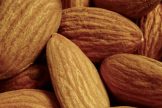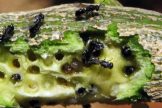
Citrus trees offer glossy green foliage year round, with sweetly scented flowers and beautiful and edible fruit. There are few trees that are as ornamental and practical as a citrus tree. Citrus are a must for every back yard. Varieties include: Cumquats, Grapefruit, Lemons, Limes, Mandarins, Oranges, Tangelos, Pumelos and various others.
Growing Conditions
Citrus trees prefer a full sun position. They will grow well with up to half a day of sun, but will produce more foliage and less flowers and fruit with less direct sunlight. They need to be protected from frost, which damages the foliage and fruit, and from wind. Good drainage is necessary for all citrus. Soils must therefore be well drained. Planting citrus in raised beds or pots is the best option if the drainage is poor. The addition of compost to the soil may help improve the drainage. Soils should be neutral to acid in pH to successfully grow citrus. Citrus are shallow-rooted trees and thus require regular watering especially during the hot summer months. Avoid digging or planting around the base of the tree. Keep the area under the tree free of grass and mulch well. Smaller varieties of citrus are ideal grown in large pots or tubs. Try Cumquats, Myer Lemons, Tahitian and Kaffir/Makrut Limes.
Mulching
Mulch Citrus in spring to conserve moisture during the hot summer months. Be careful not to build the mulch up around the trunk of the trees, as this may cause collar rot. Remove the previous years mulch before putting a new layer down.
Feeding
At a minimum citrus should be fertilised with Fruit & Citrus Food in early September and again in early March. In addition to this, under the mulch layer, a layer of manure and compost may be spread. Some older leaves may yellow as flowering is initiated. If the trees are well fertilised, mulched and watered during summer then an autumn application of fertiliser should be all that is required to keep the leaves green in winter. Alternatively, a liquid fertiliser may be used in winter as a quick green up.
Pruning
Pruning is really only necessary to remove dead wood and to cut out branches that are rubbing against each other; or to shape the tree as desired. Citrus Gall Wasp is prevalent in this area, so prune out all galls. Remove all shoots that come from below the graft.
Watering
Citrus are not deep rooted trees and thus require regular watering. Care must be taken to ensure they have
adequate water during the hot summer months. Do not over water citrus trees.
Pests
Aphids: usually found on new growth, particularly in spring and autumn. Squash by hand or use Garlic and Chilli sprays, Pyrethrum.
Scale insects: various types of scale affect citrus trees. These will be different colours, and are usually found near the mid vein and on the stems. Again, spring and autumn are the usual seasons when these are more
prevalent. Squash by hand or spray with White Oil or Eco Oil making sure to cover the insects.
Citrus Leaf Miner: These leave silvery trails in the leaf and the leaf edges curl inwards. Control using White Oil.
Citrus gall wasps (Bruchophagus fellis) are small (3mm) shiny black wasps native to northern Australia. Adult wasps emerge in spring, often timing emergence with the onset of a flush of new growth. The wasps have a limited flying range, so, unless they are moved by the wind, they tend to re-infest the trees they emerged from. After mating, the female immediately lays her eggs into the soft new season flush.
Best practice includes:
- Reduce the amount of soft spring flush growth by pruning (and gall removal) and fertilising in late summer or autumn instead of late winter and spring .Use a balanced fertiliser rather than a highly nitrogenous one.
- Spraying with Overhaul – a Kaolin clay product in spring and summer
- Placing sticky traps (see below) into the trees around spring to catch emerging wasps and prevent them mating and laying eggs into the new growth. Adult wasps don’t fly far. They can be moved good distances by wind, but will tend to re-infect the tree they emerged from. Hence traps are useful to prevent re-infection.
- Remove galls before spring, wrap and place in your rubbish bin (NOT your greenwaste bin).
- Where possible, get neighbours involved and protecting their trees as well.
Sooty Mold and Ants: these are secondary problems arising from another pest problem. The presence of Sooty Mold and / or Ants is usually an indication that there is a Scale or Aphid problem. The Ants and Sooty Mold feed from the sticky exudate of the Scale and Aphids. Control the Scale or Aphids and these other problems will disappear.
Mineral Deficiencies And Other Problems
Iron Deficiency
Yellowing, mainly of the newer growth, with the veins standing out in green. Apply Chelated Iron at recommended rate. The pH of the soil may be too alkaline, making the iron is inaccessible to the plant. A trace element mixture may be added to the soil, to cover various other deficiencies.
Lack of Fruit
Trees purchased with fruit on may not fruit for several years after planting. It is best to remove the developing fruit early on young trees, so that more energy is used up in root and foliage growth to establish a strong tree. Heavy crops of fruit may result in smaller sized fruit. To avoid these problems it is best to thin out heavy crops, by thinning the newly set fruit on each branch by half to two thirds. Wheeny Grapefruit tend to fruit every second year and Mandarins may produce such dense growth they fail to fruit. Other causes usually result from uneven growing conditions, over fertilising and drought or waterlogging.
Citrus Rootstocks
For those of you who want to know EVERTYHING! Citrus are grafted onto rootstocks in order to give the tree protection from pests and diseases, greater tolerance for specific soil conditions, a shorter time before full fruit production is reached, tolerance to cold (or heat), to drought or waterlogging. There are different rootstocks to serve different purposes. At BAAG we commonly see four different rootstocks:
Trifoliata – Poncirus trifoliata. Excellent tolerance to phytopthera, Tristeza and citrus nematode, poor resistance to Exocortis, poor tolerance to salinity and alkalinity. Excellent tolerance to poor drainage, good tolerance to sandy and loamy soils. Cold hardy. Shallow rooting, but dense fibrous roots. Generally highly fruitful with very good quality fruit. Poor drought tolerance. Incompatible with Eureka Lemon
Troyer root stock. Good phytopthera resistance, excellent Tristeza resistance, limited Exocortis tolerance, moderate nematode resistance. Good in sandy, loamy or poorly drained soils. Moderately tolerant of salinity, limited alkalinity tolerance. Very cold hardy. Gives trees high productivity and good quality fruit. Benefits from additional micronutrients, and calcareous soils leads to micronutrient deficiency. Medium rooting. Incompatible with Eureka lemon
Rough lemon . Rough lemon is a very good rootstock for producing large highly drought tolerant healthy trees with extensive lateral and vertical root development, however it tends to produce fruit rough in texture and lower in juice. These negative effects can be at least partly countered by adjusting nutrition programs but rough lemon also tends to produce larger fruit with thicker skins. Commonly used with Eureka lemons due to their incompatibility with other rootstocks.
Flying dragon rootstock – Poncirus trifoliata ‘Flying Dragon’. This citrus rootstock is used to dwarf the variety grafted onto it. It is a mutated Trifoliatia species which has hooked thorns and is much slower growing. Due to the difficulty and slowness in growing Flying Dragon, Citrus varieties grafted onto this variety are usually more expensive. It imparts the same characteristics to the scion, including cold hardiness, tolerance to root fungi and nematodes. The tree grown on this rootstock grows to about 1.5 – 2 meters in size which is about half the size of a normal citrus tree depending on the variety of tree. Dwarf Citrus trees grow well and are as strong as general types of citrus trees with the same quality and size of fruit.





